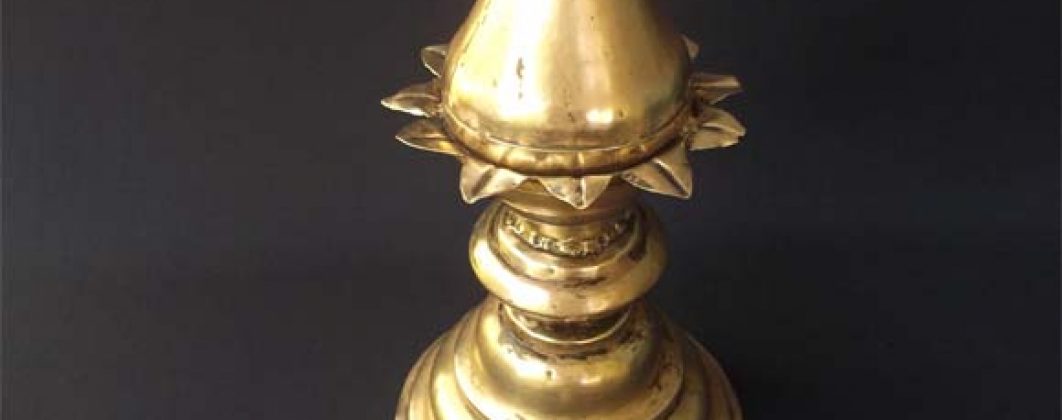
Kalasam is the most sacred symbol of Hindu religion. All Hindu religious rituals start first with kalasa pooja. It is considered as Sarva Devata Roopam (image of all Gods), Sarva Veda Roopam (image of all vedas ) and Sarva Divya Nadee Roopam (image of all sacred rivers). Because of its sacred nature, kalasam is invariably found on the top of temples, temple towers, temple chariots, and on temple umbrellas. The kalasams are made with brass and some of them are coated with gold. I have collected a magnificent temple umbrella kalasam and I am happy to introduce this sacred artifact to you.

The significance of Kalasam in Hindu religious rituals:
Firstly, we will talk about how to make a kalasam. Take a copper or silver pot of medium size and fill water till half. Decorate the pot with sandalwood paste, haldi (turmeric) and kumkum and place few mango leaves around the mouth of the pot in such a way that the stem portion of the leaves are in the pot and the other half is above the rim of the pot. Now take a coconut with the fibre handle and decorate the same with sandalwood paste, haldi and kumkum. Place the coconut in inverted position on the opening of the pot with the fibre handle facing upwards. Now the kalasam is ready. The kalasam has to be sanctified by inviting the Gods, Goddesses, Vedas, and the holy waters from the oceans and Bhoodevi by chanting the following mantra. While reciting the mantra, keep the right hand on the top of the kalasam.
”Kalasasya Mukhey Vishnu, Kantey Rudra Samaasritaah,
Mooleytatra Sthitho Brahma, Madhyou Maatru Ganaasshritaa.
Kukshoutu Saagaraa Sarrvey, Sapta Dweepaa Vasundharaa,
Rugvedodha Yajurve Ydassaamaved Ohyadharvanah.”
By reciting this mantra we do ‘Aavahanam,‘ that is inviting the following Gods and the holy creations of God to come and occupy their positions in the pot to make it sacred.
We invite Lord Vishnu to the mukha or opening of the pot, Rudra to the neck, Brahma to the base, all matruganas (Goddesses) to the center, all oceans, seven dweepas (continents) and the entire earth, and all four Vedas to the belly of the kalasam.
Now we do Aavahanam, that is invite all sacred rivers to the kalasam by reciting the following mantra.
”Gangeycha Yamunneychaiva Godaavari Saraswati,
Narmadaa Sindhu Kaaveyri Jaley Asmin Sannidhim Kuru”
Now all the sacred rivers, Ganga, Yamuna, Godavari, Saraswati, Narmada, Sindhu and Kavery have been invited and settled in the kalasam.
Now the kalasam is the personification of sarva devatas (all Gods), sarva divyanadee (all sacred rivers) and Sarva vedam (all vedas). It now becomes sacred. Symbolic to this, kalasams are made with brass and are placed on the top of the temple umbrellas. One such brass umbrella kalasam is in my collection.

Temple Umbrella Kalasam Design
The kalasam has a beautiful shape and is hand made with brass sheet. It is designed basically in two parts. The bottom part is a round stepped pedestal that sits on the umbrella. The second part is the actual kalasam that has a pot decorated with eleven mango leaves around it. An inverted coconut sits at the opening of the pot with the conical fibre part on the top. Since the kalasam is sacred, it is kept on a pedestal. The entire kalasam is hollow so that the top end of the wooden pole of the umbrella can be inserted into it. There are two holes in the middle of the kalasam. These holes are meant to drive the screws to hold the kalasam securely to the umbrella pole. The kalasam on the top of the umbrella serves two purposes, first it covers the naked wooden pole that protrudes out of the upper part of the umbrella, and secondly, the holy kalasam brings divinity to the ordinary umbrella.
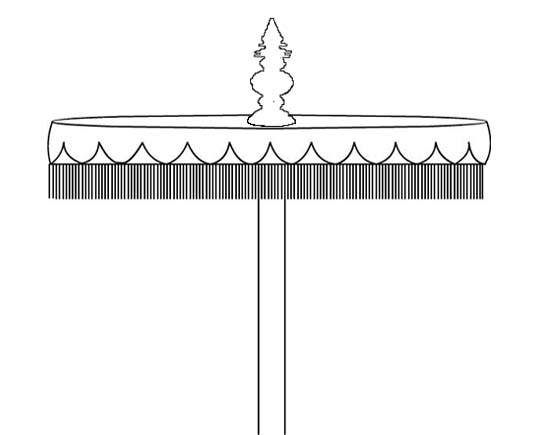





Measurements of the brass temple umbrella kalasam
The height of the kalasam from bottom to the top is 15 inches. The diameter of the base pedestal is 8.5 inches. The round top of the pedestal is 5 inches diameter. The protruding mango leaves are one inch long each.
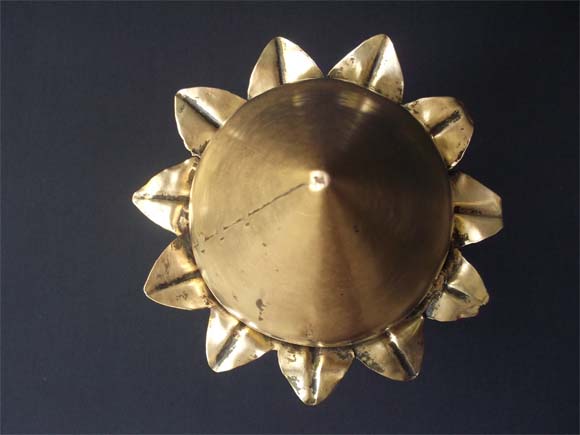
Temple procession
It is a part of the ritual poojas to the Gods to take them out on a procession, seated on various vahanas (mounts) around the temple streets with royal regalia. The procession consists of the God/Goddess seated on the vahana which can be a palanquin, chariot or animal or bird vahanas carried by men. The Gods on the vahana are invariably covered by decorated large umbrellas held by archakas (priests). These umbrellas are mounted with a kalasam made out of brass on the top of the umbrellas. There will be a leading procession in front of the God consisting of nadaswaram, drums, tableaus, traditional dances like kolatam, bhajans, garaga dances, puliveshalu, yakshagana characters. These colorful art forms and performances add life to the procession and make the procession vibrant. Thousands of devotees participate in the procession. Though there will be colourful electric lights, there must be the traditional oil kagada (torch) in the lead. The devotees participate with pomp, gaiety and spiritual fervour.
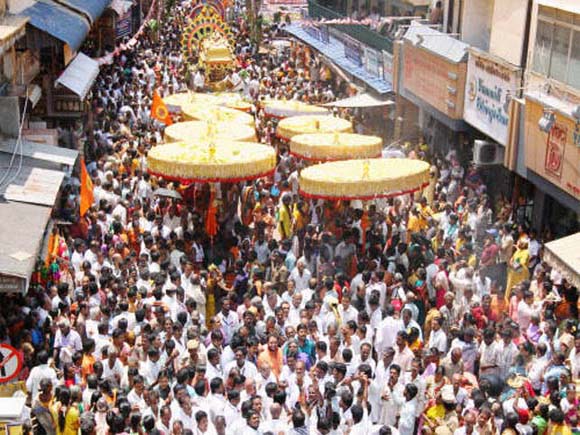
The Tradition of Annual Tirupati Umbrella Procession in Chennai
An organisation called Tirupati Umbrella Charities and Hindu Dharmartha Samiti donates special umbrellas to Lord Venkateswara at Tirupati every year. Ten decorated umbrellas, two big and eight small, are taken on a procession in Chennai for two weeks and finally reach Tirupati on the day of Garuduseva during Brahmostavam of Lord Venkateswara. The umbrellas are used for the procession on Garudostavam (fifth day of Brahmostavam). The umbrella procession starts from Suncoovari house in George Town in Chennai and this house belongs to one of the founder members of the endowment. The distance from Chennai to Tirupati is 176 kilometres and this distance is covered by the procession in 14 days, stopping en-route at many places for devotees to offer worship to the umbrellas considered as Lord Venkateswara personified. The procession consists of 150 people. The procession stops at Tiruchanoor and two umbrellas are offered to Padmavathi Ammavaaru, the consort of Venkateswara Swamy. On reaching Tirupati, the umbrellas are received by the Devasthanam with due honour and they are paraded on the Garudaseva day.
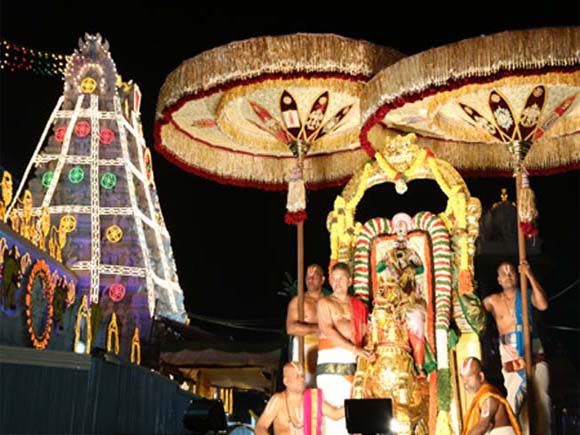
These umbrellas are specially made by the traditional experts. The handle is made with teak wood and the collapsible frame work of umbrella is made of cane. The covering cloth is made of pure silk. The wood work and the silk lace work are done in Chennai and the cane/bamboo work is done in Kanchipuram and the final assembly is done in Chennai. The umbrellas are massive and fine pieces of art work. All these umbrellas are fitted with brass kalasams.
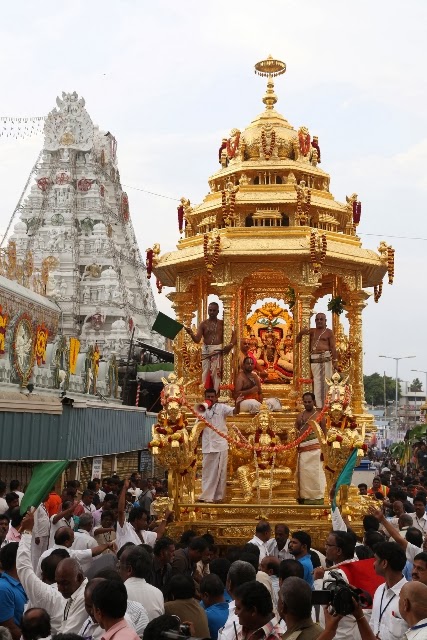
I purchased this beautiful item from an antique dealer in Chennai in the year 1968. Whenever I see this kalasam in my collection, images of great processions of temples with colourful umbrellas decked with kalasam on top pass through my mind. I drift to a spiritual state of mind where I see everything blissful, beautiful and celebration. I hope and wish you too experience the same feeling.

Copyright © 2021 YK Antiques Home Museum
One Response
Dear Sir
Very excellent and highly educative article. The mantra to invite all sacred rivers is very useful. It reminded me of my childhood days. When I was a small boy, Respectful Shri. K. Padam, a great Sanskrit Pundit, used to teach us Sanskrit during Sundays and School Holidays, in Nanganallur of South Madras. He taught us the mantra to be chanted everyday when we take bath so that each day one can get the benefit of Divya Nadhi Snanam. There is a slight ‘pada beda’ in the Version of the Sloka taught by him to us. Instead of ‘Jaley Asmin Sannidhim Kuru’ we chant ‘Theerthesmin Sannidhim Kuru’.
Regards
U.Viswanathan